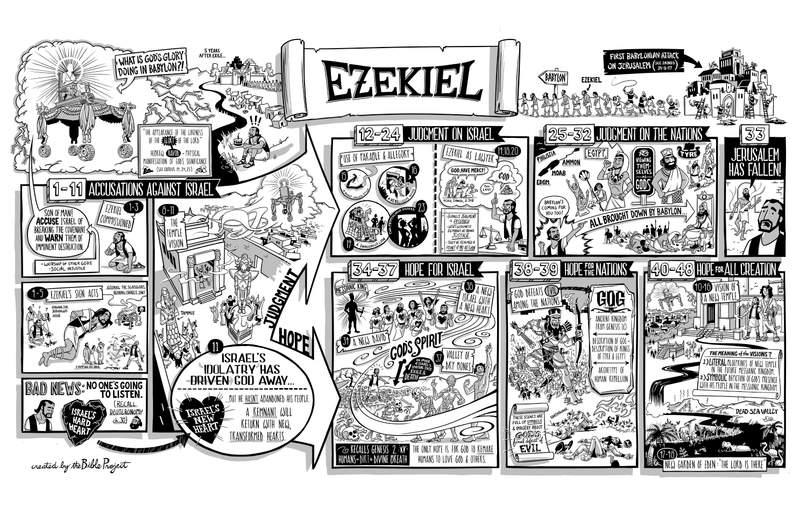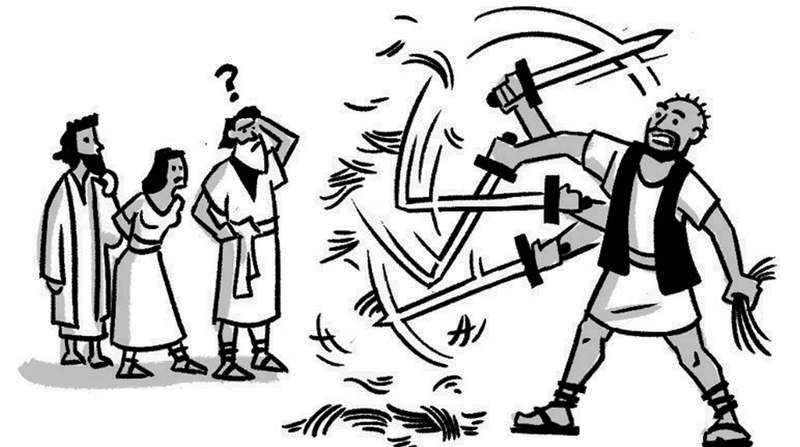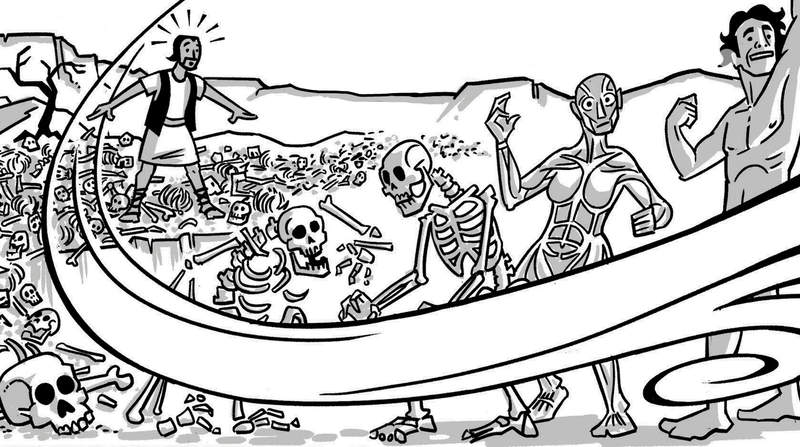The Book of Ezekiel
About

Ezekiel was a priest who had been living in Jerusalem during the first Babylonian attack on the city (2 Kgs. 24:8-17). The city itself was spared, but the king of Babylon took a first wave of Israelite prisoners into exile. Ezekiel was among them. The book begins five years after these traumatic events, and we find Ezekiel sitting on the bank of an irrigation canal near his Israelite refugee camp, on his 30th birthday no less. It’s the year that he would have been installed as a priest in Jerusalem.
Who Wrote the Book of Ezekiel?
Context
Key Themes
- Idolatry and covenant violation against God
- Judgment of the nations and Israel
- The hope of a “new David,” the messianic king
- The restored temple and restored humanity
Structure
Ezekiel 1-11: Commissioning, Sign Acts, and God’s Departure From the Temple
All of a sudden, he has a vision and sees a storm cloud approaching, and within the cloud, he sees four strange creatures connected by their outstretched wings. Each of the creatures has four faces—a human, a lion, an ox, and an eagle—and each of the creatures is atop a wheel. Their wings support a dazzling platform that holds a throne with a mysterious human-like figure shrouded in fire and glowing light. Ezekiel realizes what he’s seeing and describes it as the “appearance of the likeness of the glory of the Lord” riding on his royal throne chariot.
The Hebrew word for “glory” is kavod, and it means “heavy” or “significant.” The biblical authors use this word to describe the physical manifestations of God’s importance when he personally appears. The images in the vision are similar to when God appeared on Mount Sinai in Exodus 19 and 24, as well as when his presence came over the ark of the covenant in Exodus 25. And that’s actually the most shocking thing about Ezekiel’s vision. God’s glorious presence is supposed to be dwelling in the Jerusalem temple. What is God’s glory doing in Babylon?! This question, which would have been obvious to any ancient Israelite, is what the first section of the book of Ezekiel sets out to answer.
God first speaks to Ezekiel from atop the throne chariot and commissions him as a prophet (chs. 1-3). He is to accuse Israel of breaking the covenant agreement with their God. Israel has given their allegiance to other gods and has been worshiping idols, which has led to rampant social injustice and violence. In response to all this, God has appointed Ezekiel to warn Israel that the first Babylonian attack on Jerusalem would be matched by a second, except this time the city and its temple will be totally destroyed.
In chapters 4-5, we see how Ezekiel gets his message across with his words and by performing sign acts, a form of ancient street theater. Ezekiel would publicly behave in strange, bizarre ways that acted as parables of his prophetic message. He was called to build a tiny model of Jerusalem and enact the coming Babylonian attack. He shaved off all his hair and chopped it up with a sword. In the most extreme case, he played the role of the scapegoat on the Day of Atonement by lying on his side for over a year, eating food cooked over human waste as a sign of the nasty food that would be eaten during the siege of Jerusalem.

Perhaps the most disheartening thing of all, however, is the bad news that God gave Ezekiel. No one was going to listen to his message. Israel would reject him because of their rebellious and “hard hearts” (Ezek. 2:4; Ezek. 3:7). This recalls Moses’ description of Israel after the wilderness rebellions and his prediction that Israel would eventually end up in exile (Deut. 30). Ezekiel had the unfortunate privilege of seeing Moses’ warning become grim reality.
After his commission, a dismayed Ezekiel began to perform his tasks. After about a year, he has another vision, in which he is taken on a “virtual tour” of the temple to see what’s happening there in his absence (chs. 8-11), and it’s not good. In the outer court in front of the temple stands a large idol statue. He sees the elders of Israel worshiping other gods, both outside and inside the temple, and he also sees women worshiping the Babylonian god Tammuz. Finally, he sees God’s glorious throne chariot move out of the most holy space and leave the temple and head east towards Babylon.
And so we come full circle. In chapter 11, we discover why and how God’s glory came to appear before Ezekiel as he sat by the canal in Babylon. Israel’s idolatry and covenant violations became so blatant and offensive that God decided to leave his own temple. The Israelites have driven their God away, and he gives the city and temple over to destruction, yet God has not abandoned his people. Rather, he goes into exile with them. At the end of the vision, God promises that he will return a remnant of Israel back to the land, transforming them by “removing their heart of stone and giving them a new, soft heart of flesh,” so that they can love and follow their God (Ezek. 11:19).
It’s a small glimmer of hope that’s quickly submerged under the reality of imminent destruction. Chapter 11 is a key transition story that helps us understand how the rest of the book of Ezekiel is designed. The next three sections are all announcements of God’s judgment, beginning with Israel (chs. 12-24), moving on to the neighboring nations (chs. 25-32), and finally addressing the city of Jerusalem itself (ch. 33). Following all this grim judgment, we find in chapters 34-48 a more hopeful conclusion for Israel, the nations, and all creation.
Ezekiel 12-24: Warnings of Israel’s Coming Judgment
Chapters 12-24 of the book of Ezekiel focus on God’s judgment coming for Israel. This is a collection of diverse poems and essays, where Ezekiel shows his fondness for parable and allegory. He portrays Israel as a burnt, useless stick (ch. 15), a rebellious wife (ch. 16), a dangerous, raging lion captured by hunters (ch. 19), and as two promiscuous sisters (ch. 23). These are all depictions of Israel’s senseless rebellion and idolatry and the ruin that results. In chapters 14, 18, and 20, Ezekiel also acts as a lawyer, arguing the case that Jerusalem’s destruction is truly deserved after centuries of covenant violation. He argues that even if the most righteous people in the world, like Noah, Daniel, and Job, were alive and praying for mercy on Israel, God wouldn’t accept their prayers. It’s far too late. God’s goodness actually demands that he bring justice on this generation of Israel. The exile has become inevitable, as they’ve reached the point of no return.
Ezekiel 25-33: Judgment on the Nations and the Destruction of Jerusalem
Next, Ezekiel focuses on the nations immediately around Israel, like Ammon, Moab, Edom, and Philistia (ch. 25), as well as the two most powerful states in the region, Egypt and Tyre (chs. 26-32). Israel has allied with these nations and adopted their gods and idols. More specifically, God accuses the kings of Tyre and Egypt of arrogantly viewing themselves as gods, defining right and wrong on their terms. He holds these kings accountable for their pride and announces that he will use Babylon to bring them down. They will face God’s justice along with everyone else.
Following these intense sections is a short story in chapter 33. Ezekiel is met by a refugee who has just arrived from Jerusalem to give him a report. Babylon has attacked the city of Jerusalem once again. This time the city has fallen, and the temple is destroyed. Ezekiel’s warnings became a reality. But in the midst of his grief, we remember the glimmer of future hope at the end of chapter 11. Jerusalem’s destruction is not the end of the story.
Ezekiel 34-37: Coming Hope After Exile
The next main part of Ezekiel (chs. 34-48) explores the aftermath of the destruction of Jerusalem and its temple. This was the most horrendous catastrophe that had ever happened to Israel, and it raised the question of whether or not God was done with his people. Back in chapter 11, however, we were left with the hope that there was still a future beyond the exile. The rest of the book of Ezekiel is designed to explore this vision of hope, first for Israel (chs. 34-37), then for the nations (chs. 38-39), and finally for all creation (chs. 40-48).
God promises Israel that he will raise up a “new David,” a future messianic king who will be the kind of leader that Israel always needed but never had (ch. 34). The new Israel that will come under this king’s reign will be transformed. God will deal with their problem of rebellion by giving them new hearts (ch. 36). Just as Moses promised (Deut. 30:6), God says that he’s going to remove Israel’s hard hearts and send his Spirit into his people to give them new, soft hearts that will love and obey their God (Ezek. 36:23-30).

This idea gets developed further in the next chapter through a strange vision (ch. 37). Ezekiel sees a huge valley filled with dried human bones and skeletons. God tells him that it’s an image of Israel’s spiritual state. Their rebellion against God has resulted in the exile, which brought a metaphorical and literal death to Israel. God then tells Ezekiel that his Spirit will come and bring them back to life. A wind comes and causes the bones to stand, filling them with breath and life and causing them to regrow skin. All of a sudden, Ezekiel sees all these new humans standing before him!
This vision recalls the story about the creation of humanity from Genesis 2, in which God made humans from dirt and divine breath. Israel and all humanity have rebelled, resulting in death, so the only hope left is that God would perform an act of new creation and remake humans in such a way that they truly live in a relationship of love with God and others.
So even if God is going to deal with the evil in the hearts of his people, some questions still remain unresolved. What about the evil still rampant in the other nations? What about the temple? This is what the final two sections of the book are all about.
Ezekiel 38-39: God Defeats Gog, a King Representing Evil Nations
First come chapters 38 and 39, where God promises to finally defeat evil among the nations, which is personified by a ruler named “Gog of the land of Magog.” The name is derived from a genealogy of ancient kingdoms in Genesis 10, which referred to powerful nations from the distant past. Ezekiel picks up this ancient name as an image of violent kingdoms in any age. This is why we find Gog allied with seven nations from all four directions of the compass. This army is a symbol of all the rebellious nations put together. This also helps us understand why Ezekiel describes Gog with images that he used earlier to describe the king of Tyre and the pharaoh of Egypt. For Ezekiel, Gog is an amalgam of all the worst rulers in the Bible, an archetype of human rebellion against God.
The basic story here is that Gog resists God’s plan to restore his people. Just like Pharaoh in the Exodus story, Gog comes to destroy them. God, however, unleashes his justice upon Gog in a flurry of scenes that don’t make literal sense when you read them in sequence. Gog is first consumed by an earthquake and once again by fire. But after that, God strikes Gog and his army down in the fields, where they lie unburied for months. It’s clear that these scenes are full of symbolic imagery. Ezekiel used his entire poetic tool set to describe how God is paving the way for a new creation by finally defeating all the human evil that has ruined his world.
Ezekiel 40-48: Vision of a Restored Temple and Renewed Creation
After God’s victory, chapters 40-48 describe how God’s presence will one day return to his people and his temple, resulting in cosmic restoration. Ezekiel has an elaborate vision of a new temple and city. He’s given a heavenly tour guide, who shows Ezekiel around this new temple complex that’s much larger and even more majestic than Solomon’s temple. There’s a new altar, new priests, and a new system of worship. After the elaborate tour, God’s glorious throne chariot that Ezekiel saw in his first vision comes back and enters this new temple.
Now, the meaning of these visions has been a source of debate for a long time. Some Jewish and Christian readers believe that this vision will be fulfilled literally one day and that these chapters offer the actual blueprints of the new temple to be built when the Messiah returns and brings God’s Kingdom. Many other Jewish and Christian readers think that this vision, like Ezekiel’s other visions, is full of symbolic imagery. They depict the reality of God’s presence returning to his people in the messianic Kingdom, but not necessarily in the form of an actual building.
Whichever view you take, it’s important to notice that Ezekiel never calls the city Jerusalem, and in chapter 47, we discover why. Ezekiel sees a tiny stream pouring out of the temple threshold, quickly becoming a raging river that flows from the temple, through the city, and out into the desert. The river empties into one of the most desolate places on planet Earth, the Dead Sea Valley. As the river advances, it leaves behind a trail of trees and life, and the Dead Sea is transformed into a living sea, teeming with plants and animals. All this imagery comes from the description of the garden of Eden in Genesis 1-2, and we can now see just how cosmic Ezekiel’s vision is. God’s plan has always been to restore all humanity and creation to his life-giving presence, exemplified in the name of this garden-city, “The Lord is there” (Ezek. 48:35).
With these stirring images, the book of Ezekiel comes to a close. Out of the darkness of Israel and all humanity’s evil emerges a future full of hope. There will be new humans in a new world animated by God’s life-giving Spirit and living in a world permeated with God’s love and justice. This is the profound hope of the prophet Ezekiel.